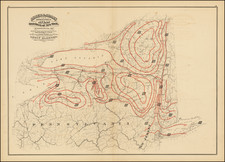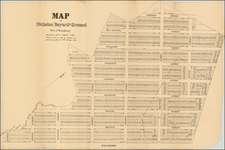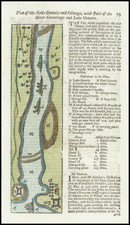Mapping The Battle of White Plains and An Early Test of General George Washington's Command
Fine original hand-color example of William Faden's Revolutionary War Plan of the Battle of New York, published in London in 1777.
The map illustrates Howe's New York campaign, with the landing on Long Island, the victory in the battle of Long Island, and pursuit of the American forces north to Fort Washington. The American forces are meticulously shown in blue, with both troop movements and fixed positions noted. Similarly the British troops and positions are tracked in red. The present example include additional place names and the addition of 5 ships off Enoch Point and Sarak Island (including the Tartar, Phenix, and Roebuck).
Nebenzhal describes the map as:
the most accurate published delineation of the movements of the armies of Washington and Howe in Westchester, from the time of the British landing through November 28, particularly focusing on the Battle of White Plains.
Faden's map illustrates an important early battle during the American Revolution, when the American success and resolve were far from certain. The map was drawn from the work of a British military engineer, Claude Joseph Sauthier, who participated in the campaigns. Nebenzahl calls the map one of the "most informative" of all the early Revolutionary War battle plans. It was printed in London, a remarkably short period of time after the events depicted on it transpired-a matter of just a few months.
The plan shows the period when the American army, still hurting from its defeat on Manhattan Island in September of 1776, was retreating to Westchester. The vastly superior British forces were in pursuit, looking for the opportunity to crush the American army and end the war. The campaign involved complex amphibious landings by the British in the Bronx and Westchester, reprising the type of maneuvers that led to the overwhelming success of the British in the Battle of Brooklyn.
Faden's map depicts the various campaigns of October and November 1776, in northern Manhattan, lower Westchester, and New Jersey. "It is the most accurate published delineation of the movements of the armies of Washington and Howe in Westchester, from the time of the British landing through November 28, particularly focusing on the Battle of White Plains." (Nebenzahl, Atlas). Clearly delineated are British and Hessian troop landings in the area of Mamaroneck, Larchmont, New Rochelle, Pelham Manor, and the Bronx. Also shown is Cornwallis' capture of Fort Lee, and the beginning of his pursuit of Washington's army through New Jersey, which would end in Washington's storied crossing of the Delaware River.
George Washington & The Battle of White Plains
The Battle of White Plains was a key military engagement during the American Revolutionary War, unfolding on the foggy morning of October 28, 1776, in the town of White Plains, New York. The engagement evolved into a bitter face-off between the British and American forces, ultimately culminating in a strategic retreat by the American troops.
Leading up to the battle, General George Washington, commanding the American forces, had made the decision to abandon Manhattan to the British forces under General William Howe after losing the Battle of Brooklyn. He moved his troops north, aiming to prevent the British from enveloping him and cutting off his escape routes. Meanwhile, General Howe, aiming to capitalize on his victory in Manhattan, pursued Washington's forces.
The British forces marched northward from New Rochelle, reaching White Plains on October 28, 1776. The American forces had taken a position on the high ground near the village, establishing a main line of resistance along a ridge running roughly east-west, just south of the village of White Plains. Chatterton Hill, a strategically significant elevation, stood to the west of this line.
Upon reaching White Plains, General Howe, understanding the strategic importance of Chatterton Hill, decided to seize it. On the morning of October 28, the British troops launched an assault, their line bolstered by Hessian troops, German auxiliaries hired by the British. The British and Hessian forces managed to overwhelm the Americans positioned on Chatterton Hill after heavy fighting, forcing them to retreat.
Despite this, the Battle of White Plains was not a clear victory for the British. General Washington had skillfully used the battle as a delaying tactic, inflicting casualties on the British and Hessians while preserving the core of his army. Following the clash, Washington and his army withdrew northward, keeping the bulk of his forces intact. This allowed them to continue the fight, eventually leading to the successful conclusion of the revolutionary war for the American side.
In essence, the Battle of White Plains, while seemingly a British tactical victory, proved to be a strategic success for the American forces. The event showcased Washington's leadership and the resilience of his troops, emphasizing their ability to adapt and survive in the face of superior British military power. Ultimately, it provided a glimmer of hope and a testament to endurance during the crucible of the American Revolution.
William Faden (1749-1836) was the most prominent London mapmaker and publisher of the late-eighteenth and early-nineteenth centuries. His father, William Mackfaden, was a printer who dropped the first part of his last name due to the Jacobite rising of 1745.
Apprenticed to an engraver in the Clothworkers' Company, he was made free of the Company in August of 1771. He entered into a partnership with the family of Thomas Jeffreys, a prolific and well-respected mapmaker who had recently died in 1771. This partnership lasted until 1776.
Also in 1776, Faden joined the Society of Civil Engineers, which later changed its name to the Smeatonian Society of Civil Engineers. The Smeatonians operated as an elite, yet practical, dining club and his membership led Faden to several engineering publications, including canal plans and plans of other new engineering projects.
Faden's star rose during the American Revolution, when he produced popular maps and atlases focused on the American colonies and the battles that raged within them. In 1783, just as the war ended, Faden inherited his father's estate, allowing him to fully control his business and expand it; in the same year he gained the title "Geographer in Ordinary to his Majesty."
Faden also commanded a large stock of British county maps, which made him attractive as a partner to the Ordnance Survey; he published the first Ordnance map in 1801, a map of Kent. The Admiralty also admired his work and acquired some of his plates which were re-issued as official naval charts.
Faden was renowned for his ingenuity as well as his business acumen. In 1796 he was awarded a gold medal by the Society of Arts. With his brother-in-law, the astronomer and painter John Russell, he created the first extant lunar globe.
After retiring in 1823 the lucrative business passed to James Wyld, a former apprentice. He died in Shepperton in 1826, leaving a large estate.











![[Assault on Fort Constitution, October 7, 1777]](https://storage.googleapis.com/raremaps/img/small/93152.jpg)

![(American Revolution) Geschichte der Revolution von Nord-America. Sammlung der besten Schriftsteller, welche die Geschichte, besondere Rechten, Sitten, und Gewohnheiten der Völker nach ihren Grundsätzen abgehandelt haben [with map:] Die Vereinigten Staaten von Nord=America. nach der Wm. Faden 1783. [History of the Revolution of North America. Collection of the Best Writers Who Have Discussed the History, Specific Laws, Customs, and Habits of the Peoples According to Their Principles [with map:] The United States of North America. According to Wm. Faden, 1783.]](https://storage.googleapis.com/raremaps/img/small/90124.jpg)
![(Viele Water Map) Sanitary & Topographical Map of the City and Island of New York [bound in:] Report of the Council of Hygiene and Public Health of the Citizens Association of New York Upon the Sanitary Condition of the City [and with map:] Sanitary and Social Chart of the Fourth Ward of the City of New York](https://storage.googleapis.com/raremaps/img/small/101301.jpg)